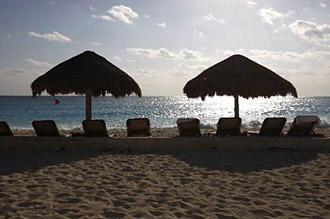
|  |  |  Travel & Outdoors Travel & Outdoors  
Mexico's Tourism Revenue Continues to Fall
 Bloomberg Bloomberg
go to original
March 24, 2010


| | Umbrellas stand over lounge chairs next to the Caribbean Sea in the Hotel Zone of Cancun, Mexico. (Andrew Harrer/Bloomberg) |  |
Mexican tourism revenue may decline for a second year as violent clashes between drug gangs and a weak U.S. job market threaten to spoil its spring break party.

Cancun and Acapulco hotels are seeing a smaller-than-normal influx of college-age revelers this month after recent reports of bloodshed, tour operators there said. Acapulco’s tourism marketing agency predicts the number of spring breakers will drop 30 percent this year to 17,500, said Piquis Rochin, director of international promotions for the organization.

"The economic crisis is still hurting us a little bit, and we’ve been affected by so much news about violence in Mexico," Rochin said in a telephone interview from Acapulco.

Mexico’s push to draw tourists, the third-biggest source of dollar inflows after oil and remittances, is getting harder as violence connected to drug trafficking persists. Mexico’s international tourism fell for the first time in a decade last year amid a weak economy and a swine-flu scare, bringing in $11.3 billion compared with $13.3 billion in 2008.

In Acapulco, 32 people were killed during the three days ended March 15. The slaying of three people tied to the U.S. consulate in Ciudad Juarez last week drew condemnation from President Barack Obama.

"Whenever the U.S. government makes a statement it somehow affects us because we are a Mexico destination," said Marina Colunga, public relations director for JW Marriott in Cancun.

The violence isn’t affecting foreign investment, Finance Minister Ernesto Cordero said in an interview yesterday in Mexico City.

"It’s likely we will have a negative short-term impact" because of the violence, Cordero said. "We are going to have to wait to see how many spring breakers visit."

Media reports have decimated the number of tourists traveling to Mexico, said Christine Hommel, a travel agent at Cherry Travel Vacations and Cruises in Matawan. She said the vacancy rate at Mexican hotels is hovering between 30 percent to 40 percent.

"There is absolutely nothing wrong in most of these resort areas," she said. "It would be, for instance, like someone saying to you that there has been some shootings in Vegas. So, are you nervous of going to Shop-Rite tonight?"

Still, the threat of violence is real for some tourists and business travelers.

Tom McCullough, 46, of Hawthorne travels to Mexico several times a year for business and to see family - his wife Carmen’s parents still live about an hour and a half outside of Mexico City in Cuernavaca.

"You hear stories," said McCullough, a banker who works in Manhattan. "When I went to Monterrey, the guy who we hired to drive us around, he said that just a few weeks before he witnessed a kidnapping in one of his cars, and a little bit of a shoot out going on. When we asked him why he didn’t call the police, he said: ‘Well, as far as we know the police were involved,’ so he wasn’t to eager to call them."

Still, that hasn’t deterred McCullough from traveling to the country.

"Yeah, I think there is real danger," he said. "But, you know, what are the odds."

The State Department reported at least 77 homicides of U.S. citizens in Mexico last year. The agency’s online database doesn’t specify the circumstances of the killings or say whether the victims were involved in the drug trade.

The University of California, Los Angeles urged students last week to avoid travel to border cities. The Texas Department of Public Safety issued a similar warning March 4.

Some University of Arkansas students canceled their trips to Mexico after "their parents told them not to go," said Steve Voorhies, a university spokesman.

The State Department advises U.S. citizens to avoid unnecessary travel to three northern Mexico states and says visitors must be cautious in border cities. While well-known tourist areas generally are safe, the violence in Mexico has increased, according to a March 14 advisory.

"Cartels and associated criminal elements have retaliated violently against individuals who speak out against them or whom they otherwise view as a threat," the advisory said.

Drug-gang killings have left 2,049 dead this year, according to El Universal newspaper, a rate that would top last year’s total of more than 6,000. At least 110 people were killed last weekend, according to Reforma newspaper.

The press office of Mexican President Felipe Calderon didn’t immediately return calls for comment. Speaking in Ciudad Juarez on March 16, Calderon said both the U.S. and Mexico are responsible for drug violence.

"This is a bi-national problem, with a common origin, which is drug consumption in the United States, and the criminal element associated with it," he said.

Spring breakers are planning trips to Panama City, Florida, and other U.S. beaches as they opt for cheaper destinations amid a weak U.S. job market, said Christina Ferraro, an event organizer for travel service StudentCity.

In Acapulco, 190 miles south of Mexico City on the Pacific coast, the number of spring breakers handled by StudentCity dropped 45 percent from last year. Cancun has fared better, with spring breakers traveling with StudentCity down 30 percent from a year ago, Ferraro said.

The U.S. unemployment rate of 9.7 percent is weighing more on tourism than the violence is, Ferraro said.

Most of the violence "is definitely outside the tourist area," Ferraro said. "The war is not with tourists or Americans."

Sean Sposito contributed to this story. |

 |
|  |



